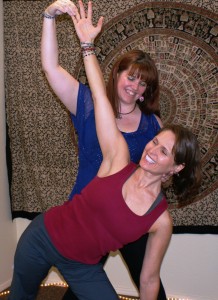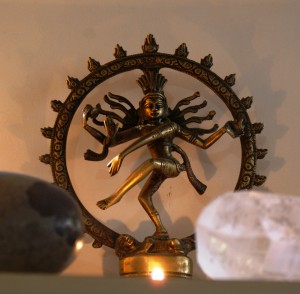 Yoga Therapy is a new distinction in the “Yoga-verse” — essentially a distinction between yoga instruction/classes and yoga as a therapeutic modality. Yoga Therapy uses time-tested yogic tools to support the remembrance of our innate wholeness. Yoga classes tend to focus on posture, breath and a little bit of meditation. These things make us feel great, but we often find this sense of peacefulness fading, sometimes on the drive home from yoga class. The yogis believe that our source of suffering comes from a false sense of separation, known as avidya. The purpose of all yoga is to reconnect with our sense of wholeness, that is our birthright.
Yoga Therapy is a new distinction in the “Yoga-verse” — essentially a distinction between yoga instruction/classes and yoga as a therapeutic modality. Yoga Therapy uses time-tested yogic tools to support the remembrance of our innate wholeness. Yoga classes tend to focus on posture, breath and a little bit of meditation. These things make us feel great, but we often find this sense of peacefulness fading, sometimes on the drive home from yoga class. The yogis believe that our source of suffering comes from a false sense of separation, known as avidya. The purpose of all yoga is to reconnect with our sense of wholeness, that is our birthright.
People tend to seek out a yoga therapist for a physical issue that has eluded healing. The yoga therapist is trained to facilitate the individual in healing on 5 levels: the physical body, the breath body, the emotional body, the mental body and the bliss body. This model is known as the Pancha Kosha model (five bodies). In a session, a yoga therapist guides you through physical movement with attention to breath and sensation in the body. Techniques like sound, non-dual awareness, yoga nidra, mudra, and meditation are often employed to work through deeply held patterns in the body.
 Yoga therapy sessions begin a commitment, called tapas in yoga. The client makes a commitment to self, how many sessions they will come for as well as a some form of daily practice. We also recognize a burning desire for change and transformation — the reason that we often find ourselves on the yoga mat.
Yoga therapy sessions begin a commitment, called tapas in yoga. The client makes a commitment to self, how many sessions they will come for as well as a some form of daily practice. We also recognize a burning desire for change and transformation — the reason that we often find ourselves on the yoga mat.
There is also a commitment to self-observation, called svadyaya. This self-awareness is a practice of being present during yogic techniques (like posture, breathing, chanting, meditation, etc), patterns of behavior, negative cognitions, reactions, etc. Self-observation gives us insight into our patterns, or samskaras, that cause us to suffer in our daily life.
These two aspects, commitment and self-observation, are represented in the form of Siva as Nataraja, the fire dancer. Nataraja is dancing in a ring of fire, committed to his practice and brilliantly aware.
 “If all we do is stand in the fire,” says Amy Weintraub, “we would burn up.” Thus, we bring in compassion, isvara-pranidanani. The process of transformation is not always easy, inviting that sense of compassion for self is important. Yet, this is a very difficult practice. How often do we berate ourselves because we did not do it ‘right?’ In the beginning, the yoga therapist often fills the role of the compassionate presence during sessions and practices. Through modeling and practice, the client develops an attitude of compassion for self. No matter what happens on the yoga mat, in a yoga therapy session, strength and success comes from commitment and self-awareness with compassion. In yoga, it is called Kriya Yoga, the Yoga of Change.
“If all we do is stand in the fire,” says Amy Weintraub, “we would burn up.” Thus, we bring in compassion, isvara-pranidanani. The process of transformation is not always easy, inviting that sense of compassion for self is important. Yet, this is a very difficult practice. How often do we berate ourselves because we did not do it ‘right?’ In the beginning, the yoga therapist often fills the role of the compassionate presence during sessions and practices. Through modeling and practice, the client develops an attitude of compassion for self. No matter what happens on the yoga mat, in a yoga therapy session, strength and success comes from commitment and self-awareness with compassion. In yoga, it is called Kriya Yoga, the Yoga of Change.
“Self-observation with compassion is the highest spiritual practice.” —Swami Kripalu
